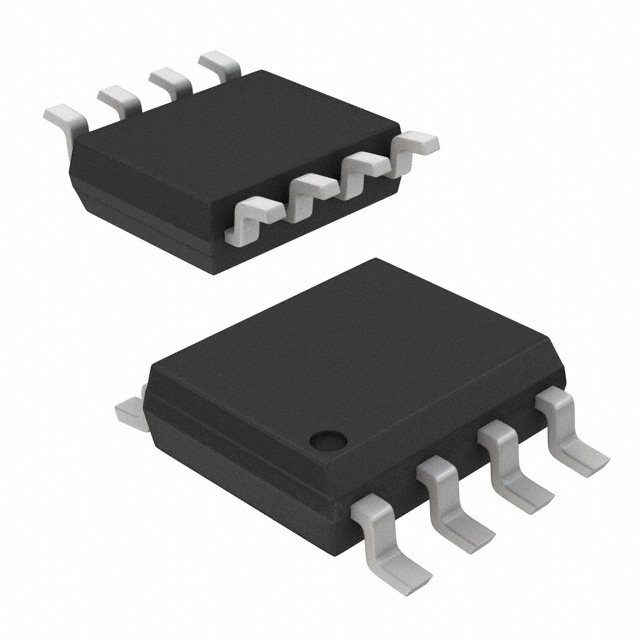Xem thông số kỹ thuật để biết chi tiết sản phẩm.

KA34063ADSTF
Product Overview
- Category: Integrated Circuit (IC)
- Use: Voltage Converter
- Characteristics: High efficiency, adjustable output voltage, low quiescent current
- Package: TO-263-5L (D2PAK)
- Essence: Step-up/Step-down DC-DC converter
- Packaging/Quantity: Tape and Reel, 2500 units per reel
Specifications
- Input Voltage Range: 3V to 40V
- Output Voltage Range: 1.25V to 40V
- Switching Frequency: Up to 100kHz
- Maximum Duty Cycle: 90%
- Quiescent Current: 2.5mA (typical)
Detailed Pin Configuration
The KA34063ADSTF IC has a total of 5 pins:
- Pin 1: GND (Ground)
- Pin 2: FB (Feedback)
- Pin 3: COMP (Compensation)
- Pin 4: SW (Switch)
- Pin 5: VIN (Input Voltage)
Functional Features
- Adjustable output voltage through external resistors
- Internal frequency compensation
- Built-in thermal shutdown protection
- Short circuit protection
- Low power consumption in standby mode
Advantages and Disadvantages
Advantages
- Wide input voltage range allows for versatile applications
- High efficiency conversion minimizes power loss
- Compact package size enables space-saving designs
- Thermal shutdown and short circuit protection enhance reliability
Disadvantages
- Limited maximum switching frequency may not be suitable for high-frequency applications
- Requires external components for proper operation
- Not suitable for high-power applications due to its small package size
Working Principles
The KA34063ADSTF is a step-up/step-down DC-DC converter that utilizes a switching regulator to efficiently convert input voltage to a desired output voltage. It operates by controlling the duty cycle of an internal switch, which in turn controls the energy transfer between the input and output.
When the switch is closed, energy is stored in an inductor. When the switch opens, the stored energy is released to the output through a diode. By adjusting the duty cycle, the output voltage can be regulated.
Detailed Application Field Plans
The KA34063ADSTF is commonly used in various applications, including:
- Battery-powered devices: Provides efficient voltage conversion for portable electronics.
- Automotive electronics: Used for voltage regulation in automotive systems.
- LED lighting: Enables efficient power supply for LED drivers.
- Industrial control systems: Used for voltage conversion in industrial automation.
- Telecommunications: Provides voltage regulation for telecom equipment.
Detailed and Complete Alternative Models
- LM2576-ADJ: Adjustable voltage regulator with similar specifications.
- MC34063A: Low-cost DC-DC converter with adjustable output.
- LT1073: Step-up/Step-down DC-DC converter with higher switching frequency.
These alternative models offer similar functionality and can be considered as substitutes for the KA34063ADSTF in various applications.
Word count: 420 words
Liệt kê 10 câu hỏi và câu trả lời thường gặp liên quan đến ứng dụng KA34063ADSTF trong giải pháp kỹ thuật
Sure! Here are 10 common questions and answers related to the application of KA34063ADSTF in technical solutions:
Q: What is KA34063ADSTF? A: KA34063ADSTF is a voltage regulator integrated circuit (IC) commonly used in various technical solutions.
Q: What is the input voltage range for KA34063ADSTF? A: The input voltage range for KA34063ADSTF typically varies from 3V to 40V.
Q: What is the output voltage range for KA34063ADSTF? A: The output voltage range for KA34063ADSTF can be adjusted using external components, but it is generally between 1.25V and 40V.
Q: How much current can KA34063ADSTF handle? A: KA34063ADSTF can handle a maximum output current of around 1.5A, depending on the specific implementation and thermal considerations.
Q: Can KA34063ADSTF be used as a step-up (boost) converter? A: Yes, KA34063ADSTF can be configured as a step-up converter to increase the output voltage higher than the input voltage.
Q: Can KA34063ADSTF be used as a step-down (buck) converter? A: Yes, KA34063ADSTF can be configured as a step-down converter to decrease the output voltage lower than the input voltage.
Q: What is the typical efficiency of KA34063ADSTF? A: The efficiency of KA34063ADSTF depends on various factors such as input/output voltage differential, load current, and external component selection. It can typically achieve efficiencies ranging from 70% to 90%.
Q: How can I calculate the external component values for KA34063ADSTF? A: The datasheet of KA34063ADSTF provides detailed application notes and formulas to calculate the required external component values based on your specific requirements.
Q: Can KA34063ADSTF be used in battery-powered applications? A: Yes, KA34063ADSTF can be used in battery-powered applications as it supports a wide input voltage range and can efficiently regulate the output voltage.
Q: Are there any important considerations when using KA34063ADSTF? A: Yes, some important considerations include thermal management, proper selection of external components, and adhering to the recommended operating conditions mentioned in the datasheet to ensure reliable operation.
Please note that these answers are general and may vary depending on the specific implementation and application requirements. It is always recommended to refer to the datasheet and consult with technical experts for accurate information.

